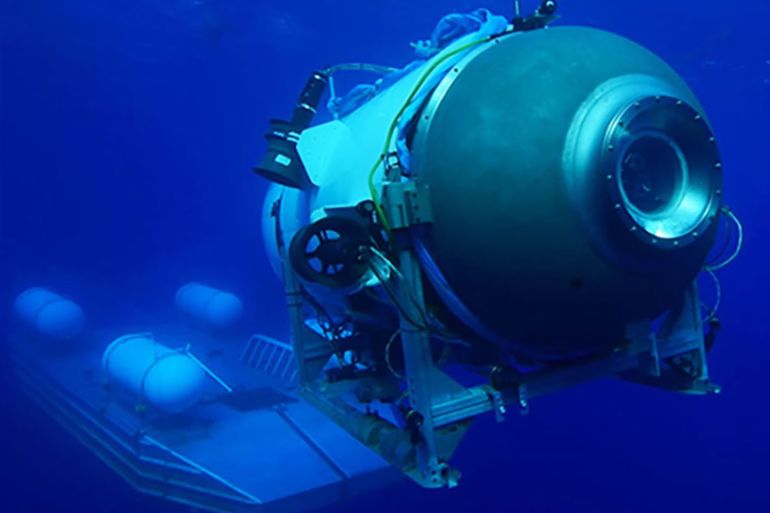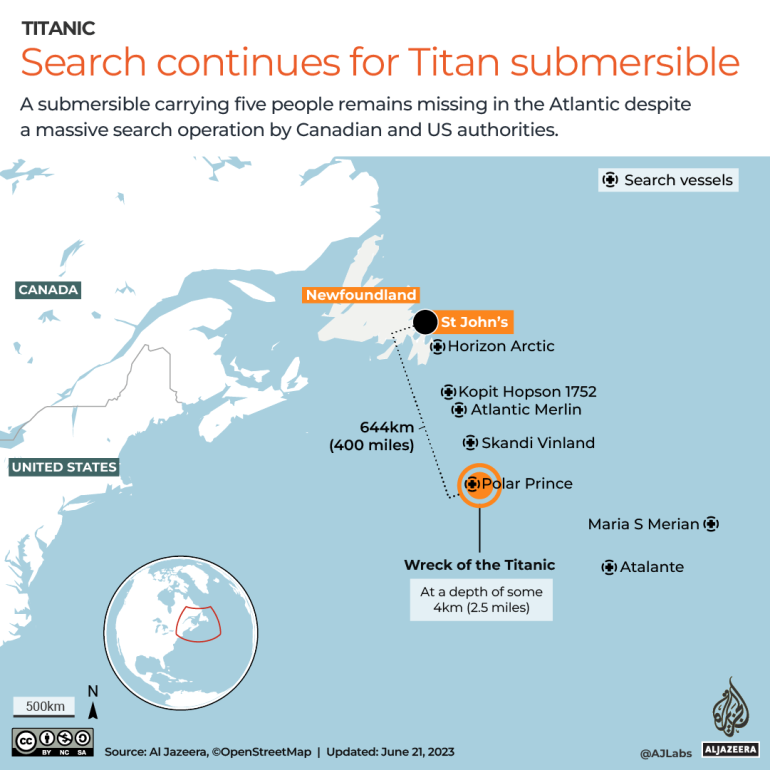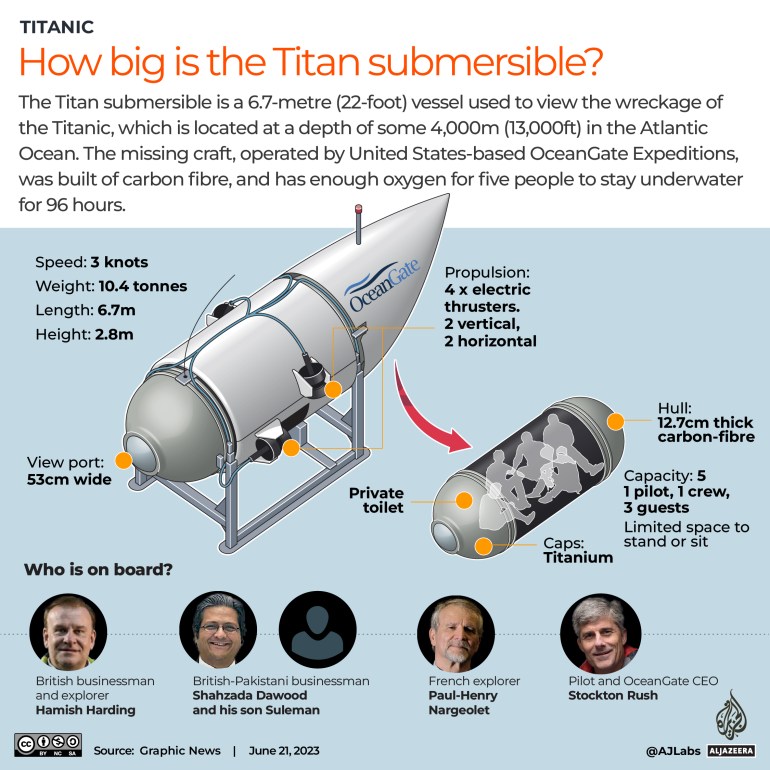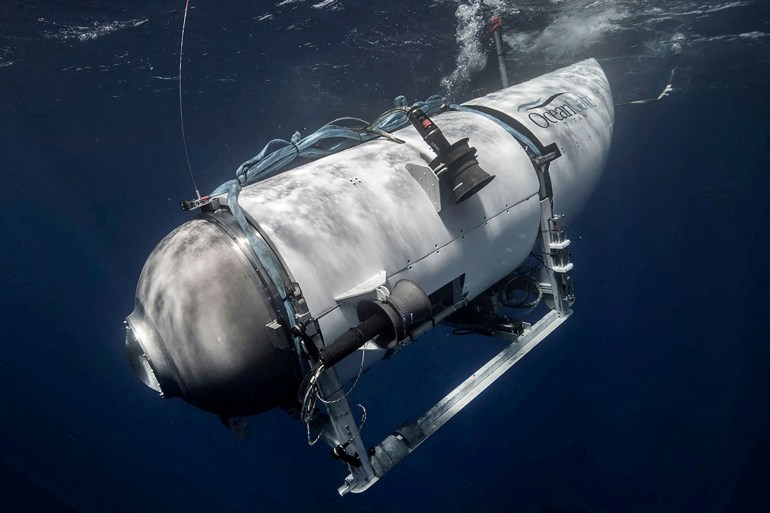Titanic sub: What are the key challenges in the search mission?
A look at the situation as rescuers search an area about half the size of Belgium for the craft with five people.

A submersible vessel taking five tourists on a deep ocean journey to view the wreckage of the Titanic went missing on Sunday, triggering an enormous search and rescue effort.
Here is a look at the situation as rescuers race against time to search an area about half the size of Belgium for the submersible, which could be on the ocean floor or bobbing on the surface, with the tourists bolted in from the outside.
Keep reading
list of 4 itemsCrews race to find Titanic sub lost in vast North Atlantic
Who is on board the missing Titanic submersible?
‘Underwater noises’ detected in search for missing Titanic sub
Time is a key concern
On Tuesday at 17:00 GMT, experts estimated the submersible had about 40 hours of breathable air left, which means rescuers have a little more than 20 hours to find the missing vessel.
“The big problem now is time,” Jonathan Holloway, a retired Royal Navy Captain in the UK that served in submarines, told Al Jazeera.
“We know that at some point, they will run out of oxygen. But of course, running out of oxygen isn’t a hard edge.
“As the oxygen levels drop, you become less able to concentrate, less able to work, and therefore less able to respond to people being outside the submersible trying to help you,” he added.
Inhospitable terrain
If the submersible is on the ocean floor, it would be nearly impossible to rescue, experts say.
The Titanic wreck is about 2.5 miles (4 kilometres) below the surface. The submersible lost contact more than halfway down on its dive.
“It’s pitch black down there. It’s freezing cold. The seabed is mud and it’s undulating. You can’t see your hand in front of your face,” said Tim Maltin, an expert on the Titanic’s sinking and wreckage.
Mike Reiss, a previous Titan passenger, said: “They might be stuck at the bottom of the ocean.
“Perhaps there was a breach, and water came in; I’m not very optimistic for their return,” he added.

Bring it up?
Experts also say that a sub-to-sub rescue is unlikely from the bottom of the sea.
Only a handful of submersible craft exist that could reach the depths of the Titanic wreck. Even if they could reach it, submersibles do not have the power to tow the missing vessel up to the surface.
“We know more about the Moon surface than the bottom of the ocean because we just haven’t surveyed it,” said Jamie Pringle, a forensic geoscientist at Keele University in Britain.
Finding it on the surface
Experts say if the vessel is bobbing at the ocean’s surface, finding it will be a needle-in-a-haystack situation.
The vessel the size of a van (length 6.7 metres and width 2.8 metres) will be even harder to spot if it is partially submerged. It is far out in the ocean, so moving ships and equipment to the large area being searched takes time.
What has been done so far?
At least 10,000 square miles (25,900 square kilometres) have been searched, according to the US Coast Guard.
The Canadian research icebreaker Polar Prince, which was supporting the Titan, was conducting surface searches with help from a Canadian Boeing P-8 Poseidon reconnaissance aircraft, and the Canadian military dropped sonar buoys to listen for any possible sounds from the Titan.
An underwater robot had also started searching in the vicinity of the Titanic, and there was a push to get salvage equipment to the scene in case the submersible is found, said Jamie Frederick of the First Coast Guard District in Boston.
Two US Lockheed C-130 Hercules aircraft were conducting overflights, and three C-17s from US Air Mobility Command have also been used to move another commercial company’s submersible and support equipment from Buffalo, New York, to St John’s to aid in the search.
A Royal Canadian Navy ship that provides a medical team specialising in dive medicine and a six-person mobile hyperbaric recompression chamber also was en route on Tuesday, according to the Canadian military.
“The absolutely critical problem is finding the submersible,” Holloway said.
“If it’s on the surface, they’ve got a fighting chance. If it is down at the depth of the wreck, then I think time is fast running out,” he added.

Where did the Titan go missing?
The crew of the Titan submersible lost contact with the crew of the Polar Prince research ship – an hour and 45 minutes after it began a dive to see the wreck on Sunday.
The wreck of the Titanic, a British ocean liner that struck an iceberg and sank on its maiden voyage in April 1912, lies about 900 miles (1,450km) east of Cape Cod, Massachusetts, and 435 miles (700km) south of St John’s, Newfoundland.
The Titanic sits on the ocean floor, about 4,000 metres (13,000 feet) below sea level.
What’s the worst-case scenario?
“The real nightmarish scenario is that they’re alive, at the surface … running out of air, and unable to get out,” David Pogue, science writer and previous Titan passenger, told media.
According to Jannicke Mikkelsen, a friend of on-board businessman Hamish Harding and fellow explorer, the lack of power is one of the main challenges.
The search is being conducted from Boston.
“They have enough oxygen to keep them alive and sustain them for 96 hours, but they also need power to stay alive, so the worst-case scenario is they have oxygen, but they don’t have power, and if they don’t have power they are going to become hypothermic pretty quickly,” she said.
Were there any previous warnings to OceanGate?
Years before OceanGate’s submersible went missing, the company faced several warnings as it prepared for its mission.
David Lochridge, OceanGate’s director of marine operations, wrote an engineering report in 2018 that said the craft under development needed more testing and that passengers might be endangered when it reached “extreme depths,” according to a lawsuit filed that year in US District Court in Seattle.
OceanGate sued Lochridge that year, accusing him of breaching a non-disclosure agreement, and he filed a counterclaim alleging that he was wrongfully fired for raising questions about testing and safety. The case settled on undisclosed terms several months after it was filed.
Further, OceanGate has said the craft was designed to reach depths of 4km (13,123 feet), where the Titanic rested.
But, according to Lochridge, the passenger viewport was only certified for depths of up to 1,300 metres (4,265 feet), and OceanGate would not pay for the manufacturer to build a viewport certified for 4,000 metres.

OceanGate also received another warning in 2018, this one from the Marine Technology Society, which describes itself as a professional group of ocean engineers, technologists, policymakers and educators.
The letter, reported by the New York Times, said society members were worried that “the current experimental approach adopted by OceanGate could result in negative outcomes (from minor to catastrophic) that would have serious consequences for everyone in the industry”. The US Coast Guard says a search covering 10,000 square miles (26,000 square kilometres) has turned up no signs of a missing submersible.